List of Iberian horse breeds
This is a list of the breeds of horse considered in Portugal and Spain to have originated wholly or partly in those countries. Inclusion here does not necessarily imply that a breed is predominantly or exclusively of Iberian origin.
| Local name(s) | English name if used | Image | Notes |
|---|---|---|---|
| Asturcón[1]:21 | 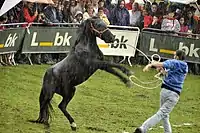 | 2001 population: 873;[2]:57semi-feral | |
| Altér Real[3]:434 | .jpg.webp) | ||
| Burguete[1]:21 | 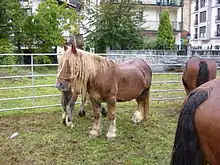 | 2001 population: 3300;[2]:57 heavy work and meat horse | |
| Caballo de Deporte Español[4] | Spanish Sport Horse | 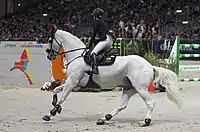 | 2001 population: 2350[2]:56 |
| Caballo de las Retuertas[1]:21 | Retuerta horse | pop. 60-140; feral, first described in 2005 | |
| Caballo de Monte del País Vasco[1]:21 | Basque Mountain Horse | 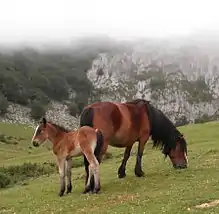 | 2001 population: 2300;[2]:57 semi-feral meat horse |
| Galician Pony | .jpg.webp) | 2001 population: 650;[2]:57semi-feral; 20,000–22,000 unregistered horses, known as faco or del país[5] | |
| Catalán | extinct since the first third of the twentieth century[1]:445 | ||
| Hispano-Árabe[1]:21 | 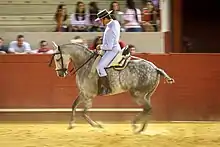 | 2001 population: 2464[2]:55 | |
| Hispano-Bretón[1]:21 | .jpg.webp) | 2001 population: 4561;[2]:57 work and meat | |
| Jaca Navarra[1]:21 |  | 2001 population: 390;[2]:57 semi-feral | |
| Losino[1]:21 | 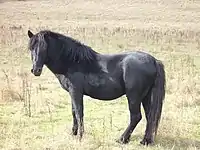 | 2001 population: 169;[2]:57 semi-feral | |
| Lusitano[6] | 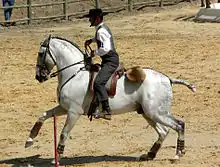 | pop. 23,619 | |
| Mallorquín[1]:21 | 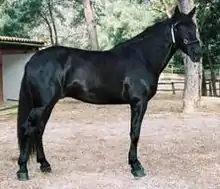 | 2001 population: 172[2]:57 | |
| Marismeño[1]:21 | .jpg.webp) | pop. 1051, semi-feral | |
| Menorquín[1]:21 | .jpg.webp) | 2001 population: 1647[2]:57 | |
| Mérens | 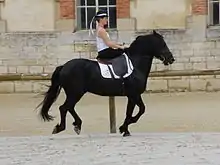 | pop. >7000[4] | |
| Monchino[1]:21 | .jpg.webp) | 2001 population: 1004[2]:57 | |
| Pirenenc Catalá[7] | .jpg.webp) | pop. 7133; recognised in 2012 | |
| Ponei da Terceira[6] | |||
| Pottoka[1]:21 | Pottok | .JPG.webp) | 2001 population: 532;[2]:57 some semi-feral |
| Andalusian horse |  | 2001 population: 75,389[2]:49 |
| Serrano | not nationally recognised, regional recognition only (Community of Madrid)[8]:100 | ||
| Sorraia[6] | 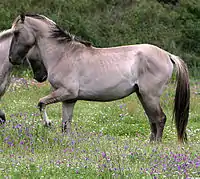 | Portugal, pop. >100, feral | |
| Trotador Español | Spanish Trotter | 2001 population: 6823, of which 85% in the Balearic Islands[2]:53 | |
References
- Miguel Fernández Rodríguez, Mariano Gómez Fernández, Juan Vicente Delgado Bermejo, Silvia Adán Belmonte, Miguel Jiménez Cabras (eds.) (2009). Guía de campo de las razas autóctonas españolas (in Spanish). Madrid: Ministerio de Medio Ambiente y Medio Rural y Marino. ISBN 9788449109461.
- [s.n.] (December 2003). Estudio y caracterizacion del sectór equino en España (in Spanish). Madrid: Tragsega; Ministerio de Agricultura, Pesca y Alimentación.
- Valerie Porter, Lawrence Alderson, Stephen J.G. Hall, D. Phillip Sponenberg (2016). Mason's World Encyclopedia of Livestock Breeds and Breeding (sixth edition). Wallingford: CABI. ISBN 9781780647944.
- Breed data sheet: Spain: Horse. Domestic Animal Diversity Information System of the Food and Agriculture Organization of the United Nations. Accessed July 2019.
- Cristina Barral (15 November 2010). Unos 22.000 caballos salvajes pastan en libertad en los montes gallegos (in Spanish). La Voz de Galicia. Accessed July 2019.
- Breed data sheet: Portugal: Horse. Domestic Animal Diversity Information System of the Food and Agriculture Organization of the United Nations. Accessed July 2019.
- [Ministerio de Medio Ambiente, y Medio Rural y Marino] (2009). Real Decreto 2129/2008, de 26 de diciembre, por el que se establece el Programa nacional de conservación, mejora y fomento de las razas ganaderas (in Spanish). Boletín Oficial del Estado (23), 27 January 2009. Accessed July 2019.
- Élise Rousseau, Yann Le Bris, Teresa Lavender Fagan (2017). Horses of the World. Princeton: Princeton University Press. ISBN 9780691167206.
This article is issued from Wikipedia. The text is licensed under Creative Commons - Attribution - Sharealike. Additional terms may apply for the media files.